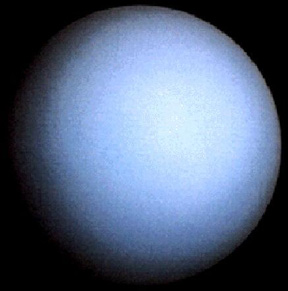
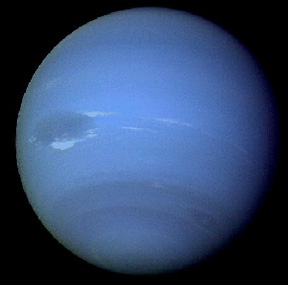
Seen in color by Voyager cameras, both planets appear similar, as shown here (Uranus on top; Neptune below):


Each has a notably bluish color due to absorption of longer wavelengths (reds and yellows) by methane gas, leading to dominance of reflected shorter wavelengths. The atmospheres possess weak banding and Neptune displays a large Dark Spot and fast moving cloud spots that represent rising plumes and turbulence. Neptune's zonal winds can move at speeds as high as 2000 km/hr - the fastest measured so far in the solar system.
The rings around each planet are few in number, faint, and thin. There are 11 rings so
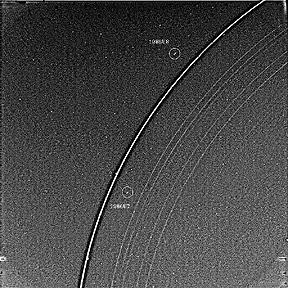
far detected around Uranus,with the outermost (Epsilon) being much brighter than the others. Two small satellites are visible on either side of the Epsilon ring. These have been called "shepherds" because they seem responsible for keeping that ring intact by pushing stray particles back into line and possibly gathering and inserting particles from beyond. One of the several rings around Neptune has a distinctive "braided" (twisted) structure:
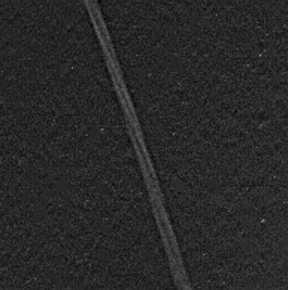
The five outermost uranian moons are also that planet's largest; they occur in the sequence: Miranda (472 km [293 miles]); Ariel (1158 km [719 miles); Umbriel (1172 km [728 miles]): Titania (1580 km [981 miles]); and Oberon (1524 km [946 miles]) (farthest out at 583,300 km [362,230 miles). Each has an icy surface, extending to unknown depths, making up about 40-50% of the volume, but ending in a rocky interior. The last four comprise a group in which all show strong similarities, with dominant features being craters (especially Umbriel and Oberon) and deep (some > 10 km [6 miles]) interconnected, gash-like valleys (particularly Titania and Ariel).
Ariel 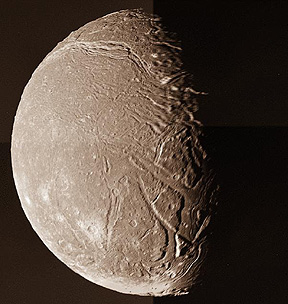
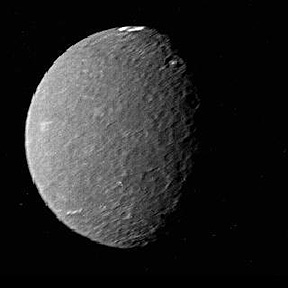 Umbriel
Umbriel
Titania 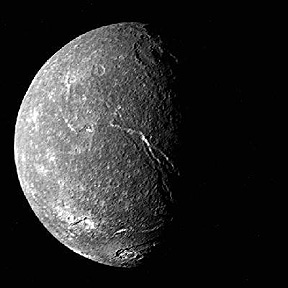
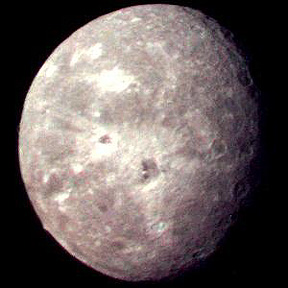 Oberon
Oberon
One hypothesis for the origin of these cracks contends that the satellites once had enough internal heat to melt the exteriors into liquid water which, upon later freezing and expansion of the ice, induced tensional fracturing.
Miranda is unique among the uranian satellites but, excepting its much smaller size, bears a strong resemblance to Ganymede in the Jovian group. By serendipity (this flyby decision was based on the need to use this satellite to give the spacecraft a gravitational boost towards Neptune), Voyager 2 made the closest approach to Miranda of any of the satellites, allowing its peculiar terrains to be imaged in detail. First look at the full view (top) - a mosaic - of one face; then (below) a close-up of the surface.
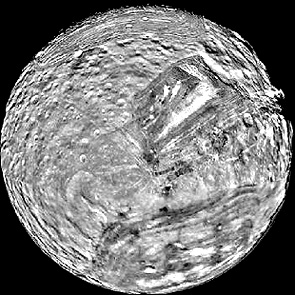
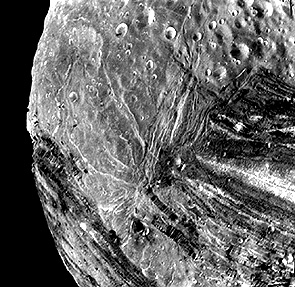
Two sharply contrasting terrains are evident. Much of Miranda's surface consists of rather bright, heavily cratered terrains, similar to the above four satellite exteriors. But there are three large oval to rectangular terrains (called "coronae") whose physiographies are quite different (to each other and to the dominant terrain). They may contain subparallel grooves, several as deep as 2 km (1.2 miles), or alternating light-dark bands, or ridges and stripes that may take sharp bends. A closer view (at bottom, above) of ridged terrain shows the boundaries of these terrains with the encompassing older terrain to be generally abrupt. The origin of these patches is still debated. An early interpretation considered them to be fragments of a shattered proto-Miranda or some other disrupted satellite incorporated in a (re-)assembling satellite. The paucity of craters in these isolated terrains argues against this. Another opinion holds them to be a mix of rock and ice that formed a crust which broke up and was invaded by upwelled ice masses from the interior.
Code 935, Goddard Space Flight Center, NASA
Written by: Nicholas M. Short, Sr. email: nmshort@epix.net
and
Jon Robinson email: Jon.W.Robinson.1@gsfc.nasa.gov
Webmaster: Bill Dickinson Jr. email: rstwebmaster@gsti.com
Web Production: Christiane Robinson, Terri Ho and Nannette Fekete
Updated: 1999.03.15.